Art Supplies I Should Not Use Anymore
When I look at my art supplies, there are many that just take up space and don’t bring me joy anymore. Recently, I have tried to use them up, but one crayon, for example, can last a long time. Maybe I should just stop using them and give them away?
This blog post is a little inventory of what art supplies don’t bring me joy anymore.
Arteza Gouache Paints
Arteza sent a big set of their gouache paints to me in 2019, and I made a blog post with a video about them.
>> Intuitive Painting in 60 Colors of Arteza Gouache Set

I prefer Schminke Horadam gouache paints, because they are much better quality.
In general, I like watercolors more than gouache paints because they are livelier and more transparent. In the course Decodashery, I have used both gouache and watercolors.

Gouache is great for decorative-style painting, so I will keep my few Schminke paints, but I should give the Arteza gouache paints away.
Derwent Artbars

I have a love-hate relationship with these crayons. I have used them quite a lot, especially with water. But always when I look at the finished piece, I think that it would have looked so much better if I had used watercolors instead. For example, this recent art journal page would have been quicker to create and much more delicate with watercolors.
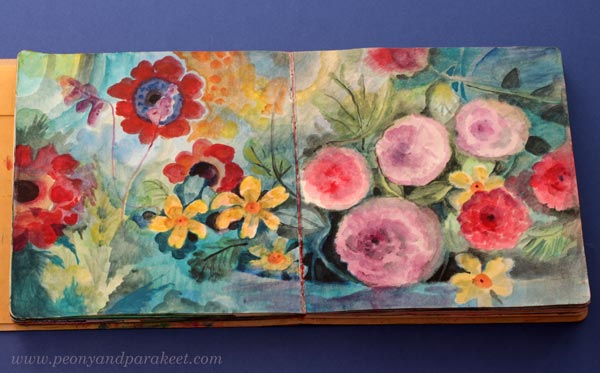
On the other hand, I really like many sketchbook pieces from 2017, like the one below.

In this blog post from December 2017, I share many projects where I have used Derwent Artbars.
I bought the Artbars somewhere around 2014, and even if I have tried to use them now and then, they may live longer than I do. I think I should either toss them or give them away. Watercolors easily replace them.
Faber-Castell Gelatos
I often wonder: “What did I think to achieve when I purchased these?”

I bought Faber-Castell Gelatos around the same time as Derwent Artbars. Mixed media enthusiasts thought that Gelatos were fun at that time, around 2010. I was very much into mixed media, and it was not difficult to sell new art supplies to me. Nowadays, I am much more traditional and don’t consider myself a mixed media artist anymore.
However, if you have Gelatos, you may enjoy this blog post from 2014 where I show some color mixing with them. >> How to Mix Colors (with Gelatos)
And this blog post where I work with Gelatos by using inspiration from art history.
>> Consistency and How to Get Inspired by It (with Gelatos)

I try to use gelatos now and then, and managed to use up one stick of the big set. But these are just a nuisance: no accuracy and not enough pigment. I should give these away.
Oil Pastels
I only have a small box of oil pastels. They really suit my art style. They have strong pigments and it’s easy to mix and blend them. Oil pastels look great a a top layer of pencil drawings and work well on top of many other art supplies too.

And I love the results! Here, the face has been painted in acrylics, there are regular pencil marks, and then the oil pastels add their flare.

See more images in this blog post from 2018: Oil Pastels and Spicing Up Your Art
I have also used a lot of oil pastels in this recent blog post: Using Up Old Crayons
And I have even made a course that uses oil pastels with other supplies. It’s called Innovative Portraits!
So, why should I not use oil pastels anymore when I seem to be so excited about them? Well, they are messy for sure, but also this: If I make a piece with oil paints instead, I can sell it and get more worth of my time. Oil paints (and acrylics) can do everything oil pastels do. Oil pastels are quicker, but the result is more valuable if I use paint. So, this is related to what kind of artist I am and what I need to get out of my time.
Alcohol Inks and Acrylic Inks
I bought alcohol inks in my mixed media years and loved them.

Alcohol inks are strong and work on any background, even on the top of acrylic paint. I used to use them to make backgrounds too, here’s one example from 2015.
And in 2012, I made many collages in the Collageland style where I also used splashes of alcohol inks, often pinks!

But now, they don’t feel so much fun anymore. Their odor is a bit disturbing too. But I have some pens that can be filled with alcohol inks, and will use the rest of them like felt-tip pens.
I also have some acrylic inks and acrylic watercolor inks.

I prefer to use watercolors instead nowadays. I should just make some art journal pages to use up those few bottles or give them away. I actually found a fun idea from an old blog post: Inktober Warm-Up Exercise (inks + drawing, from 2019)
All That Glows
Gold, silver, pearlescent effects – they are not my thing. I love to imitate glowing effects with regular paints, but glowing surfaces are not what I like to create. I have tried too many times, and made some fun pieces too, like this one from 2020.
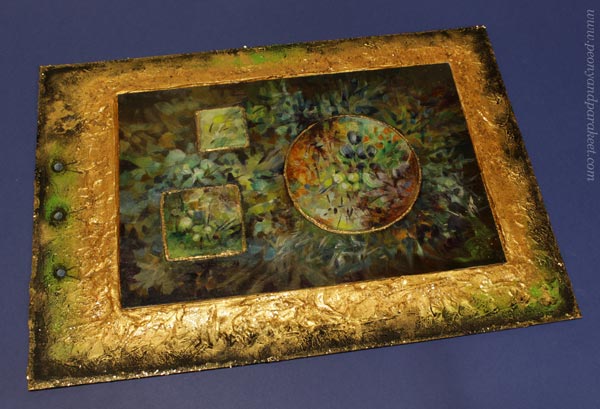
See more images in the blog post: Impressionistic Floral Painting on Structure Paste
And see how lovely glitter glue looks on the box cover, made in the course Doll World!

I have already given away many glittering paints, and I intend to give away the few that I still have.
Special Mediums
When visiting an art supply store, it’s tempting to try a new medium. I have velázquez oil painting medium, masking fluid, granulation medium, fiber paste …
Some of these mediums are for adding surface effects. For example, fiber paste creates a surface that can then be used for watercolors. Velázquez medium is for those who like to paint thickly. The more I have painted in oil, the smoother surface I want. For me, the smooth quality of the surface feels important to achieve. Smooth paintings bring old masterpieces to mind.
I know many use masking fluid and granulation medium for watercolors. I have used masking fluid in the course Watercolor Journey, but have stopped using it. There are ways to avoid it so masking fluid feels unnecessary nowadays. Granulation medium is not a miracle medium either. I like to keep my watercolors with water only. I think they don’t enjoy the makeup!
However, in Watercolor Journey, we use the masking fuild in a fun way – for doodling – and I think the result is fun!
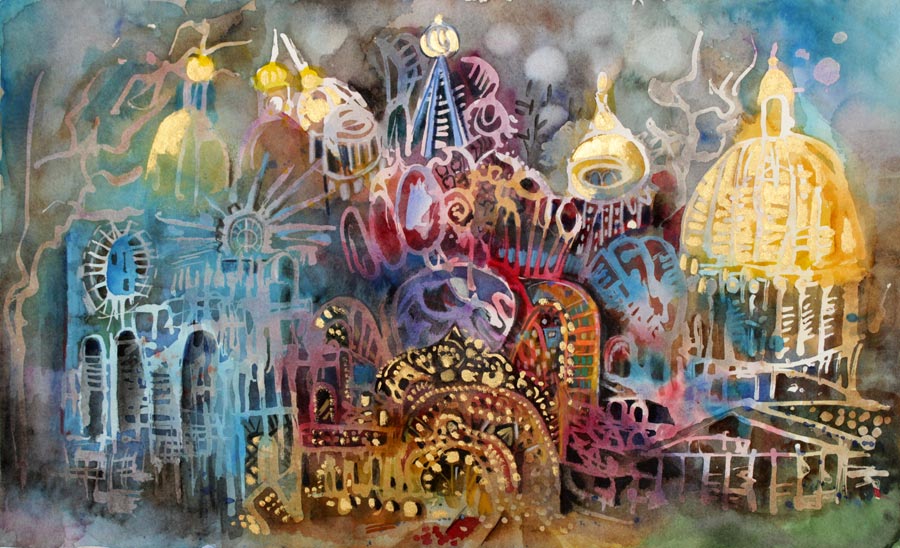
I have some masking fluid and granulation medium left. Maybe I should make some art journal pages with this doodling approach to quickly use them up!
My Basic Art Supplies
These are the basic supplies, I want to keep: oil paints, acrylic paints, watercolors, watercolor pencils, colored pencils, and felt-tip pens. Oil paints and acrylic paints are mainly for canvas paintings. Watercolors are mainly for watercolor paintings. And colored pencils and felt-tip pens are mostly for art journal pages and small drawings.
Mediums
With oil paints, I need painting medium. And with acrylics, I like to use gel medium and glazing medium for thinning in addition to water. I could give up the gel medium if I had to choose, because the glazing medium works better for thin layers. Then comes the question: how minimal to go and what would it serve?
What do you think?
However, nowadays when I want to have a treat while visiting an art supply store, I buy a new color, for example, a new colored pencil or a new tube of oil paint.
Filling an Art Journal
One of my projects this summer is to fill one of my art journals – Dylusions Creative Journal Square. I hope that these pics from my current in-progress journal, inspire you to start filling your art journal!

Reaching Saturation Point in Filling Art Journal
I think art journals have a saturation point. When most of the pages are full, you have to give the book a little more attention than usual. This journal was started in 2020, and I have filled it here and there over the years.

One spread can have things done in many different years. So the book is full of temporal layers, and I think they make the best art journal.

and finally added a zebra made in the style of Animal Inkdom.
Magical Inkdom also has fun projects for these kind of small drawings.
Practicing in an Art Journal
My courses appear a lot in my art journal, because I often practice on the pages or later glue pictures I made for the courses into it. I hope my course participants do the same!

and then added some more painted petals in acrylic.
Journaled “Sweet” with watercolors.
Part of being an artist is to be happy with your own development, and also to be interested in what you have done before.
This and That Will Magically Come Together
When my art journal is full, I will make a video of it, where I go through it and talk about each spread. I also know that when the journal is finished, the flow of the spreads feels much more coherent than when I was filling them.

In the style of Freely Grown.
One thing that applies to all art journals, sketchbooks, and notebooks is that they are most beautiful when full. When you purchase one, it looks too beautiful to fill, but once you hold a full one, it feels much more valuable. I am looking forward to that!
Art Supplies and Emotions
This week, we ponder what kind of feelings and emotions our art supplies raise in us.
Do you remember these small paintings from a few weeks ago?
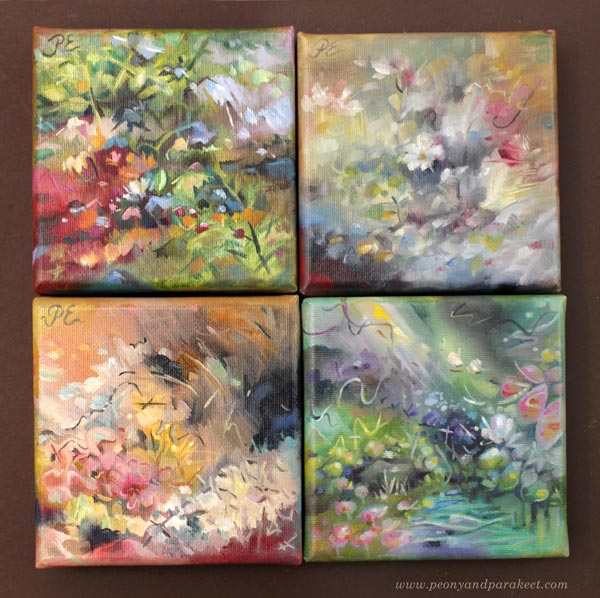
I now got the fourth one finished, and I couldn’t resist taking a photo of them together. These are only 6 by 6 inches, and the small size enables me to study a style or an idea before making a bigger painting. So, in a way, these are like pages in an art journal – small art that is delightful to create and look at but that doesn’t fill a wall. It’s the first time I feel I can create quick experiments directly in oils. And this brings us to the topic of art supplies.
Crayons, Inks, and All the Possibilities
I have now painted on canvas in oil for over two years, and most of the other art supplies don’t inspire me so much anymore. I have all kinds of crayons, inks, and paint tubes that were purchased in a different mindset many years ago.
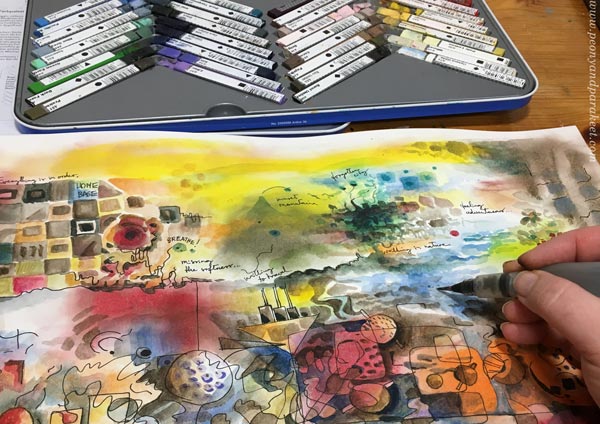
Back then, a new supply meant a new beginning. Purchasing a box of crayons meant that I still believed in myself – that there was still hope that I will become an artist. See a video of me working with crayons – a blog post from 2017.
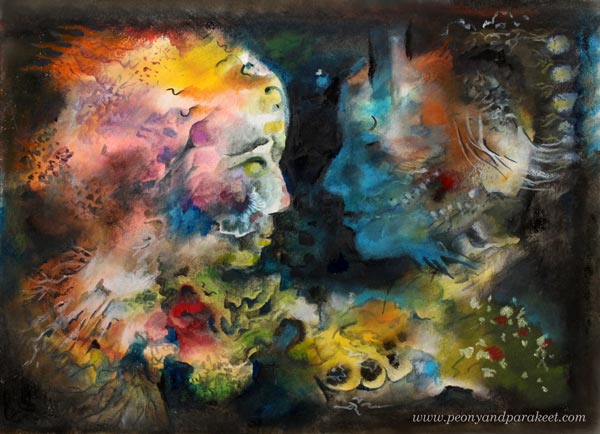
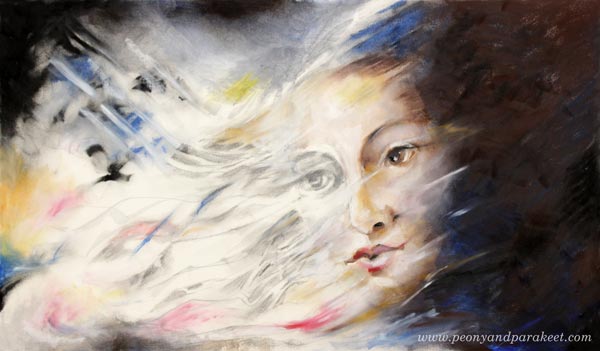
I like many of the pieces that I created back then, but now when I look at those boxes of crayons, the magic has gone away. All I can hear is the calling of my beloved oil paints.
There are two exceptions though.
Colored Pencils Are the Easiest Art Supplies
Colored Pencils bring me back to my childhood when I was drawing with my elder sisters, admiring what they did with them. For me, colored pencils were not just pencils, but dolls that had names. It was sad to see a doll that I loved get shortened and then finally thrown away!
Compared to oil paints, colored pencils have an advantage. There’s no preparation involved. When I paint with oils, I need to build the palette, clean the caps, select the brushes, protect the tabletop, etc. But with colored pencils, I can just grab a piece of paper or open another page in a journal and start coloring freely. When I am tired but still want to create something, it’s really nice.

I have also liked to maintain my illustration skills, and colored pencils are great for that too. For example, see the newest course Doll World!
Watercolors Are a Great Teacher
I am also emotionally connected with my watercolor set. Even if I haven’t used it much lately, I feel that painting in a watercolor set my style. Many techniques that I use in oil were learned when I was painting in watercolor, for example, negative painting and building an image layer by layer.
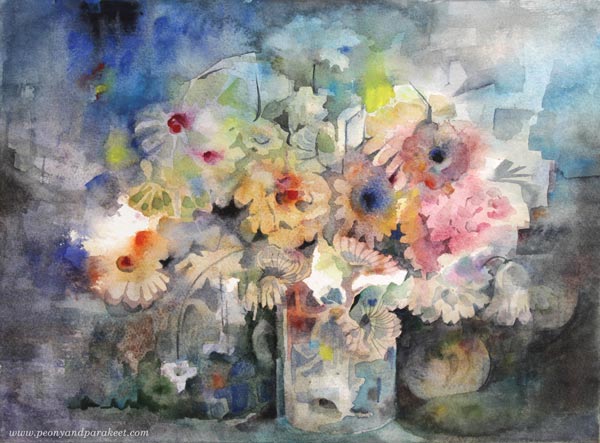
I also learned a lot about pigments and their behavior back then. It was a good learning experience to paint many pieces in a row.
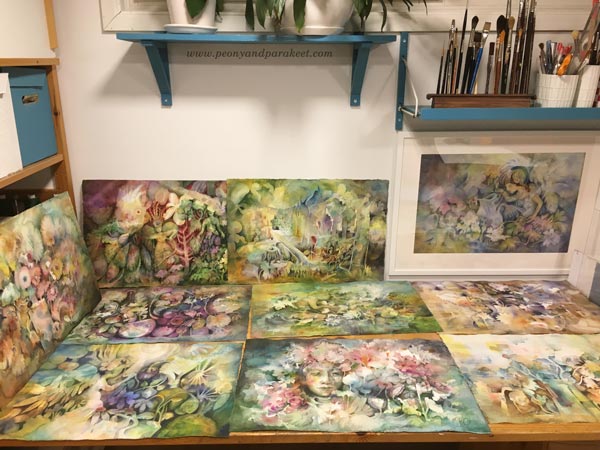
I have several courses on watercolor, for example, Magical Forest for fairies and Floral Fantasies for floral still lives!
What about all those inks, crayons, and such, did I learn anything from them? Yes, of course, but when I look back, it feels like when I started to focus more on one media instead of mixed media, I also took a big leap forward in skills. My art went forward when I no longer tried to find a solution by changing the media but by growing the skill. I was also able to get a more emotional connection with the supplies and somehow that feels very important to me.
Oils vs. Acrylics as Art Supplies
Before oils, I painted in acrylics for some time. They are more practical. They don’t smell like wet oil does. The painting mediums have less odor too. They dry fast so painting is much faster, no need to wait for days before adding a new layer or making the finishing touches. Acrylics don’t require a similar kind of knowledge of pigments and painting mediums as oils do. In oils, you have to be careful with some pigments and the use of mediums because they may cause crackling.
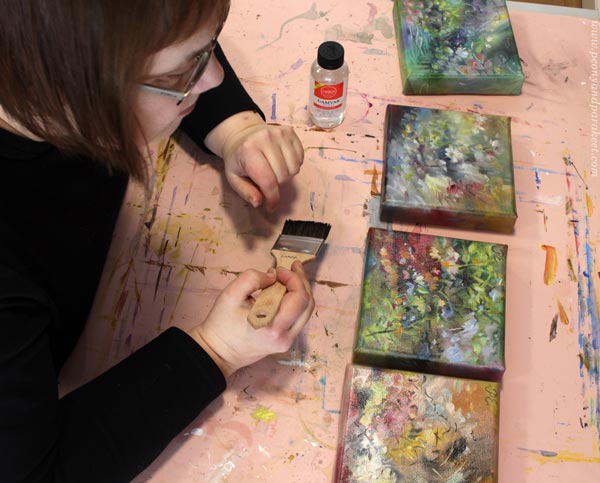
Despite all that worry, when I open my box of oil tubes, I feel different than if I pick acrylics.
The Emotions I Get When Painting in Oil
The oil paints connect me to the past. They take me to the time before I was even born.
Within seconds, I travel back to the beginning of the 20th century, meet the early abstract painters and impressionists, then continue my journey to the 19th century and meet pre-raphaelites, and move from them to those who wanted to capture the realism, and to those who were more romantics. Then again, within seconds, I go to the 18th century and admire all the floral still lives and women in beautiful dresses.
And at best, I continue the journey to the 17th and 16th centuries and see big paintings full of details. Then I also meet the masters that had the patience to make really thin layers and wait for each to dry before adding a new one.
This time traveling enables me to meet long-time friends like Wassily Kandinsky, Peter Paul Rubens, and Leonardo da Vinci and if I do some browsing before I start painting, I always find a new one that I want to meet and learn from.
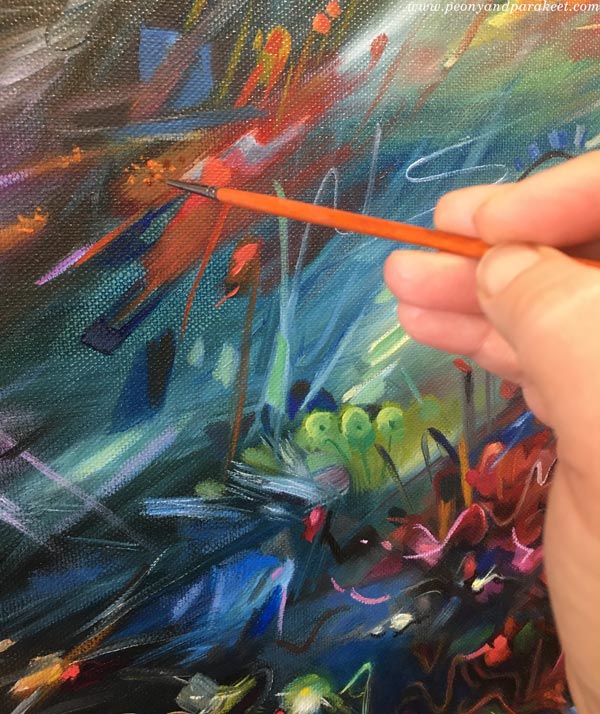
And now when I am painting for the upcoming Albert Edelfelt -themed exhibition, I also learn from him.
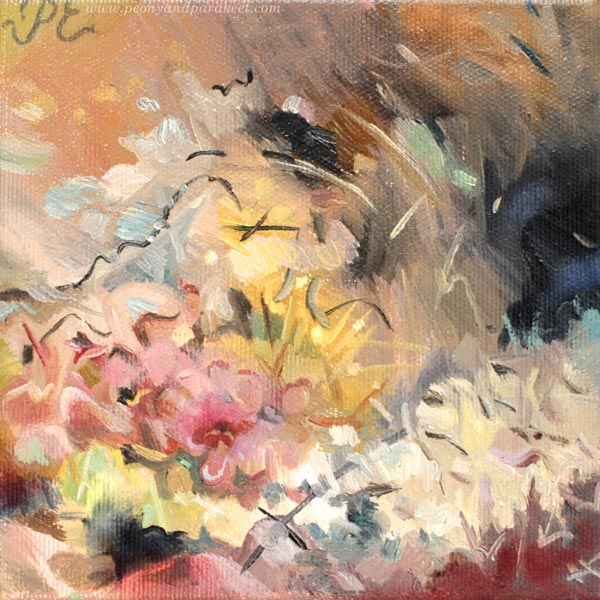
There are many great artists today, but I feel that tracing what you love back to history is essential to artistic growth. I also get satisfaction from knowing that I belong to the chain of generations. Artists from the past, still live through me.
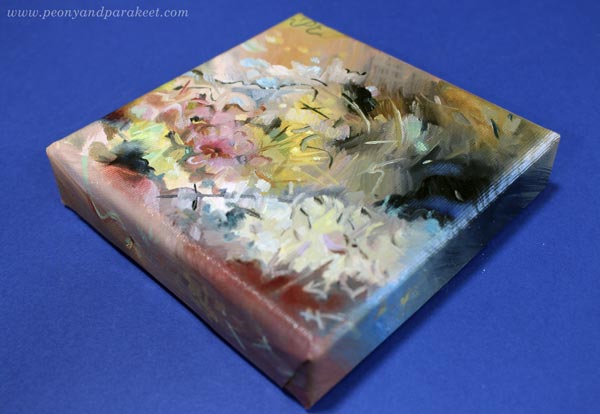
Paintings In Progress
I have been painting quite a lot recently, and there are many more paintings in the queue.
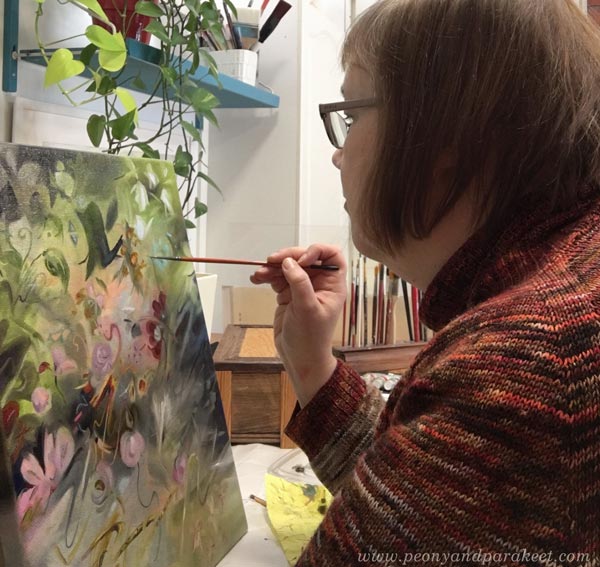
These are in-progress pictures! I will show you the finished ones in the near future!
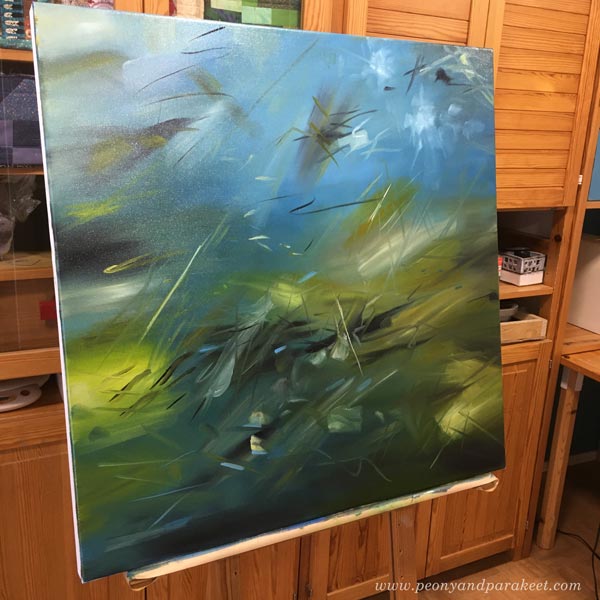
I usually reserve a whole day for painting and try not to do anything else at the same time. If you want to follow a painting day, look for my Instagram stories where I usually post in-progress photos when I am testing the composition and such.
What are Your Favorite Art Supplies?
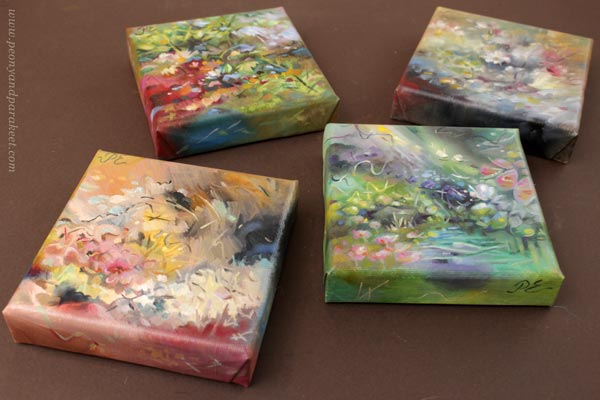
Tell us what are your favorite art supplies at the moment!
It would also be interesting to know which supplies raise emotions in you.
Revamp Art Journal Pages So That They Spark Joy!
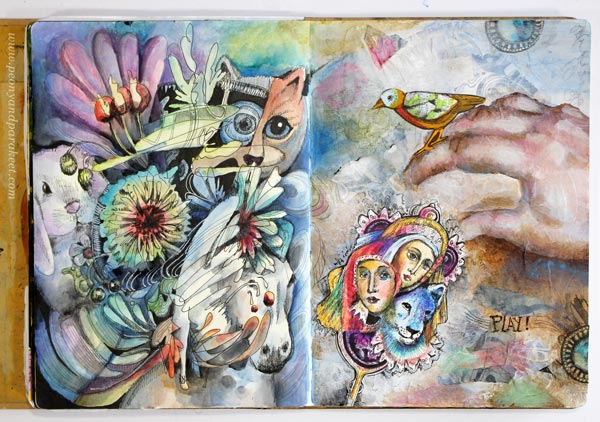
Here’s an art journal spread that I just finished. First, it was just a couple of old black and white drawings that – like Marie Kondo would put it – didn’t spark joy. But I used the old floral drawings as an inspirational foundation for the revamped spread. How and why revamp art? Keep reading!
Why Revamp Art?
The more confident I have become in creating art, the more I have begun to see the potential in my old art. Busy sketches, not so beautiful messes, and clumsy paintings and drawings all show the level of inspiration that still satisfies me. It’s the level of execution that I want to change. I want to tidy up some messes and add more expression and depth. I am certain that Marie Kondo would approve the idea of working with the old art journal pages. Isn’t it quite minimalistic compared to buying new journals all the time?
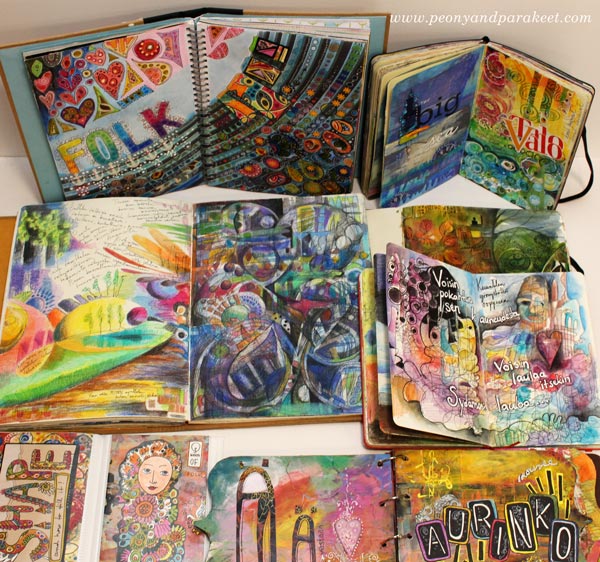
Revamp 1 – Change the Topic of the Page
Maintain the composition but change the topic of the page!
Here’s the spread before I started re-working it. It has a couple of carelessly drawn floral clusters.
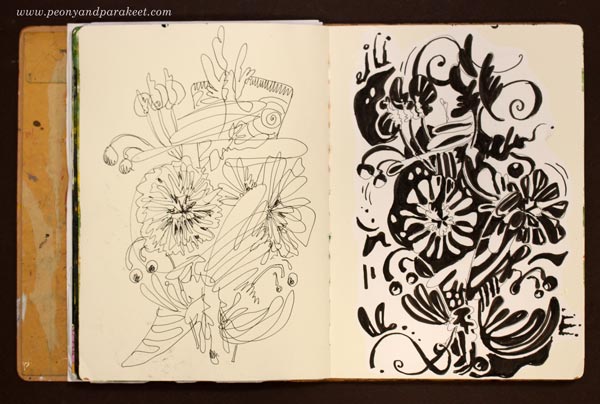
I changed most of the flowers of the left page to animals, added more details and shadows, and made the lines and shapes neater.
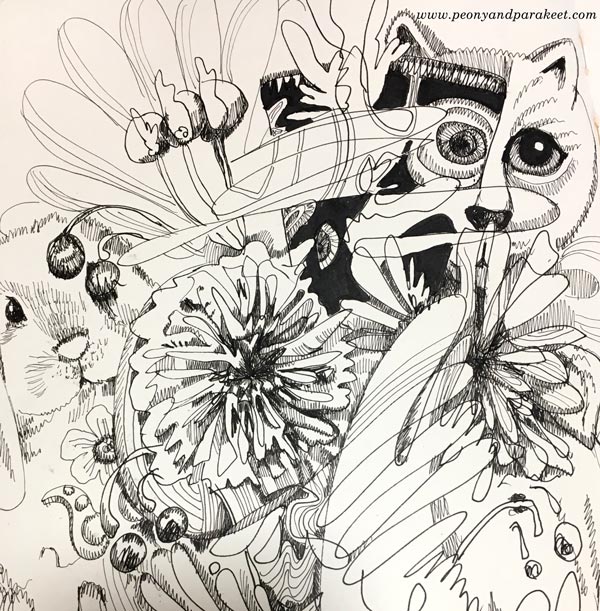
Then I used Derwent Artbars to color the line drawing.
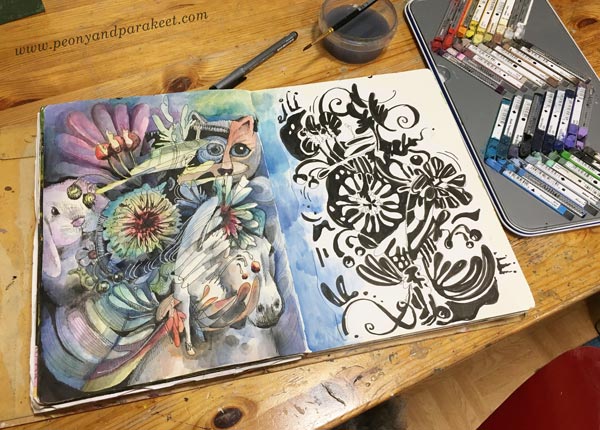
Revamp 2 – Tear the Page and Make Collage Art
I made some more drastic changes to the other page. I ripped parts of the black and white drawing that had been glued there. Then I went to my boxes of joy – the boxes that hold my hand-drawn collage pieces – and picked this motif.
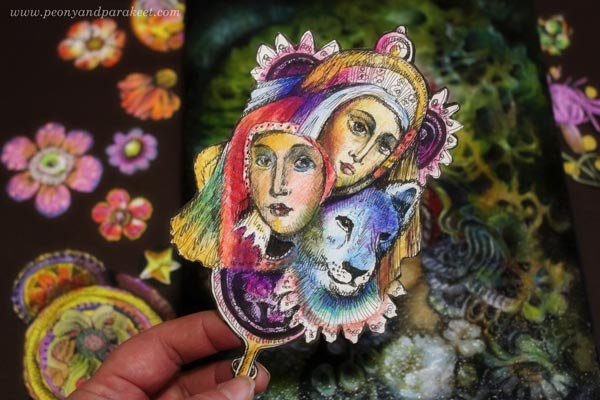
The background was painted with white acrylic paint. I worked in layers, glued some of the ripped pieces and doodled carelessly, then added more paint.
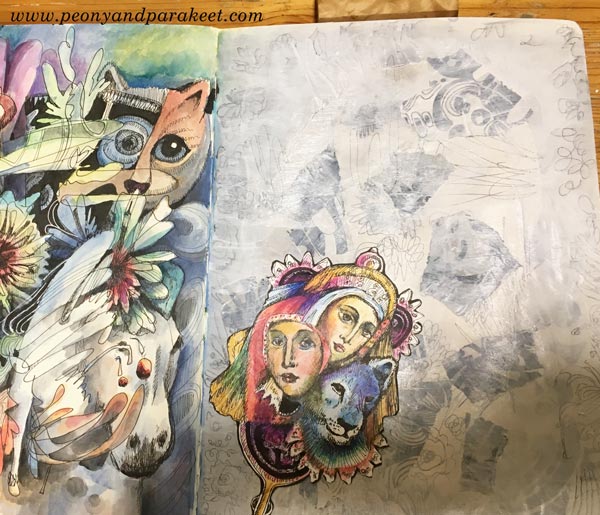
Revamp 3 – Paint Over a Part of the Page
I wanted to include a hand showing how I currently play with my art. I took a quick photo and used it as a reference.
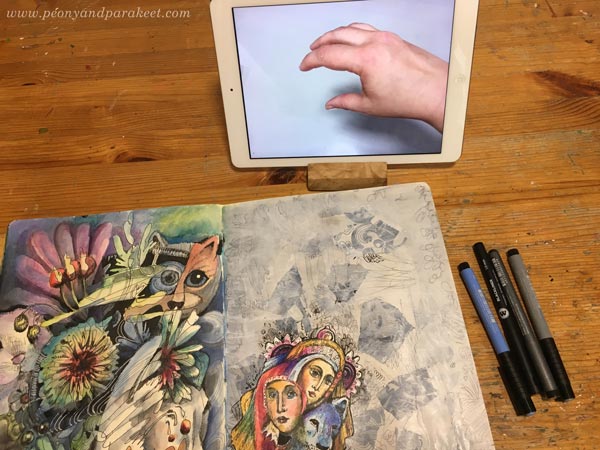
See how similar a page from my first art journal from 2010 is!
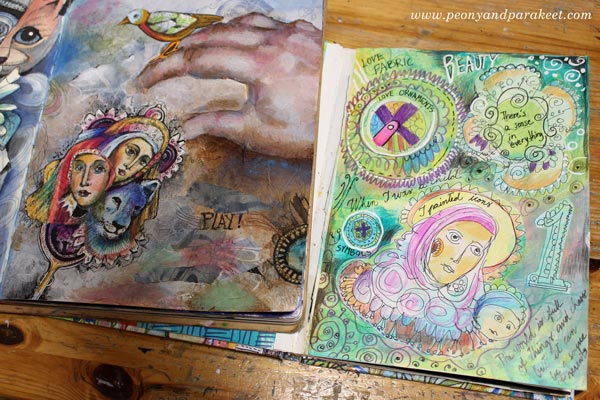
Have you documented your creative play? How you do it and how it makes you feel?
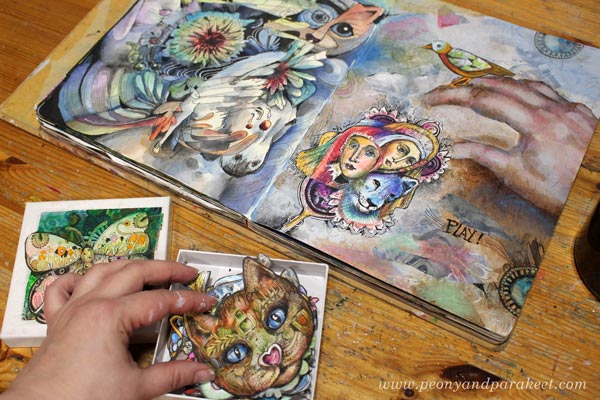
Revamp 4 – Cover a Page with a Piece from the Archive
Before I finished the spread above, I re-vamped another spread. This one only had some doodles on the right page, and then a drawing inspired by Mark Rothko glued on the left one.
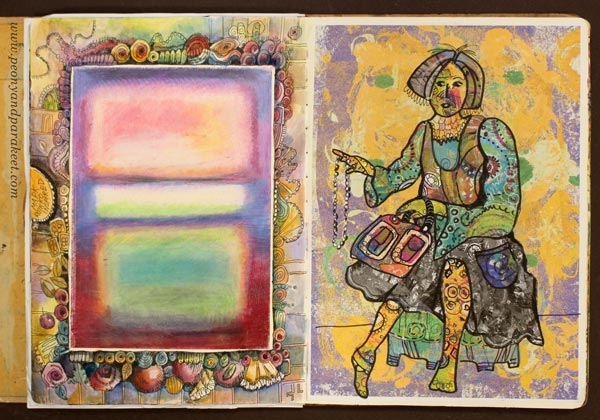
I found an old hand-drawn collage and glued it on the right page. In 2010, the collage was disappointing to me. I wanted to find my style and as a fashion illustration, the image looked clumsy.
However, it seems now that I wasn’t able to translate the message of the image correctly. Now, the piece makes me smile – there I am, sitting and handing the things that have always been inspirational to me: jewels and bags! I just wasn’t able to draw them like I did last October so I didn’t realize that they are the key elements for my visual voice.
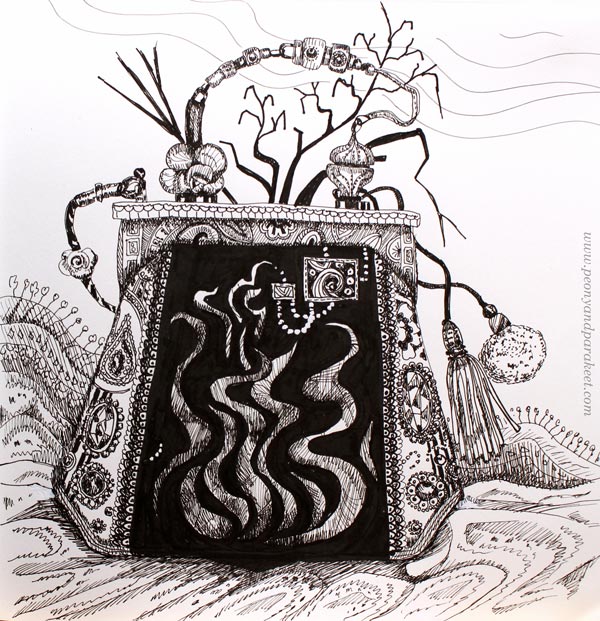
My collage was saying: “You should draw more bags and jewels, Paivi!” What does your old art speak to you now?
Revamp 5 – Add a Decorative Frame
During the years, I have made quite many of Mark Rothko inspired drawings, see this blog post! I love detailed drawings, and no matter how skillfully I would try to replicate Mark Rothko and other minimalists, I was never satisfied with the result.
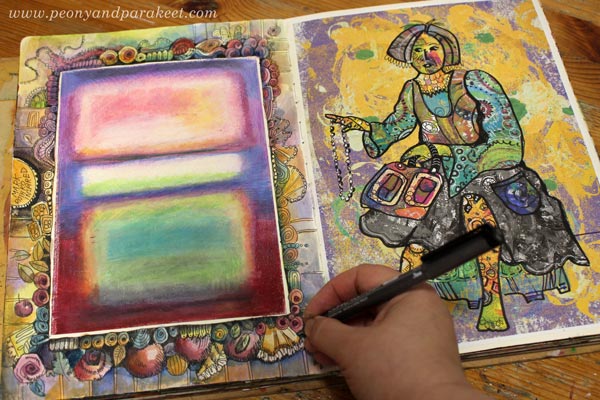
I wanted to hug the idea though and make a decorative frame around the old abstract.
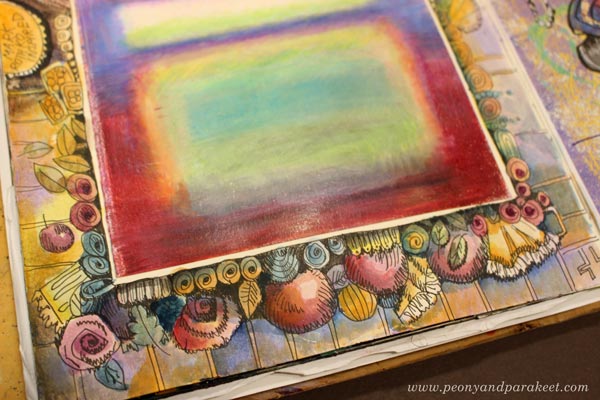
This way I am saying that the level of inspiration is there – Mark Rothko really makes me want to create whenever I look at his paintings. But the level of execution that I enjoy and am best at is something totally different.
This spread really sparks joy to me now, and I also couldn’t resist playing a bit with the collage pieces.
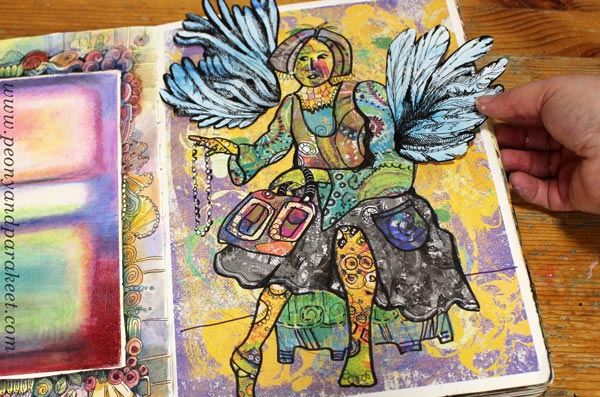
Isn’t it amazing how similar the style can be after so so many years, and after spending so long time trying to figure it out!
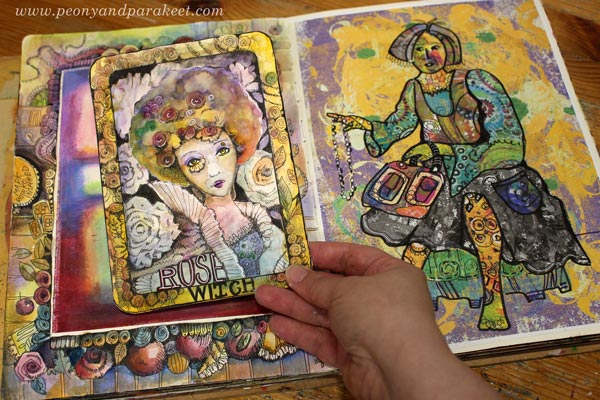
Here’s to Mark Rothko!
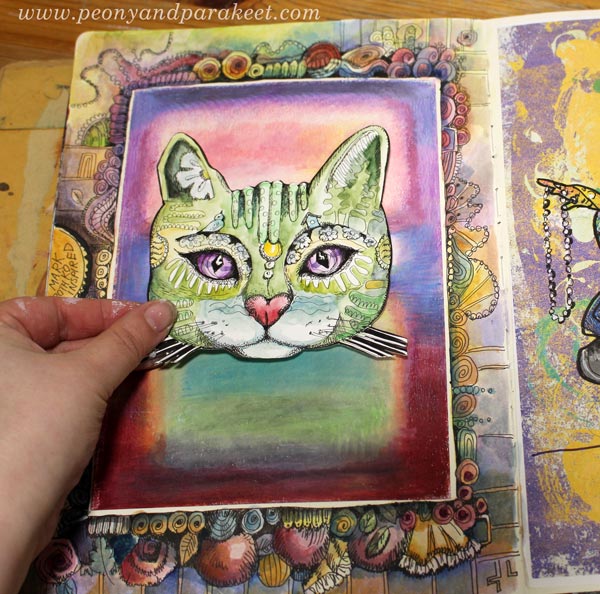
I am loving playing with the old art journal spreads, building the bridges between the years. If you separate inspiration from execution, does it make you look at your art in different eyes?
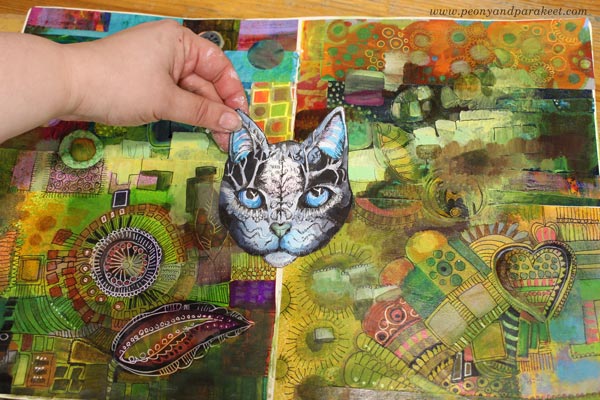
The Idea For This Blog Post Came from These
a) One of my notebooks mixes writing and drawing so that randomly scribble, doodle, and write there. It’s a private journal, and I didn’t want to publish its pages but the more full it has got, the more I have realized that when the sketches and writings are not organized chronologically, and I can revamp the pages repeatedly, they naturally produce new ideas.
b) Mackie d’Arge, a wonderful fellow artist from the USA, has shown her beautiful art in my art community Bloom and Fly. She has made many pieces by rebuilding and revamping her old artworks. It has given me the idea of looking at the potential of my old art and what could be made from there.
c) My classes Animal Inkdom and the upcoming Magical Inkdom are all about playing by drawing. I have wanted these classes to be fun, so they have made me include humor, fantasy, and play in my artistic process as well. They have made sure that my boxes of hand-drawn collage pieces stay filled even if I would “shop” there all the time! In Magical Inkdom, we will also draw decorative frames. >> Sign up Now!